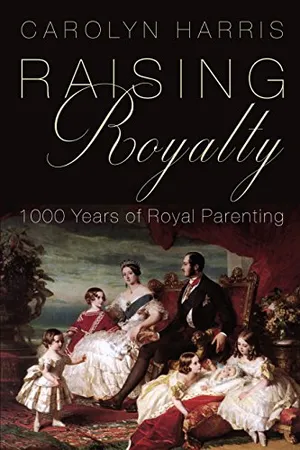Medieval Mothers Had to Marry and Murder to Get Their Way
The stories are below aren’t pulled from “Game of Thrones.” Promise
/https://tf-cmsv2-smithsonianmag-media.s3.amazonaws.com/filer/34/fb/34fba13b-824f-4926-b00d-e08740cc3540/pictures_of_english_history_plate_ix_-_the_wicked_queen_elfrida-wr.jpg)
In the rough-and-tumble setting of medieval England, royal mothers were expected to do far more than just ensure their children, the future monarchs, were healthy and well-educated. She had to wield all her influence and patronage to keep her son in power—and keep her husband from killing him.
Before the Norman Conquest of 1066, royal succession was not fixed. The inheritance rights of young children were often passed over to ensure that an experienced warrior was on the throne. It provided the perfect recipe for royal intrigue, and mothers with sons to defend often faced down tradition—and their own husbands—along the way. Queens were supposed to value their roles as both wives and mothers, but when forced to pick between the two, their children always came first.
During the Roman Empire’s rule of Britain, the wives of emperors were well-known public figures whose conduct was scrutinized—and frequently criticized. The Anglo-Saxon queens that followed had no public role or even the title of queen. But in the 10th century, Elfrida refused to honor this relatively recent convention. She was not content to exist in the shadows as “the king’s wife,” and when her husband, Edgar the Peaceable, took the crown in 973, she was crowned with him.
The king had a son from a previous marriage, but Elfrida insisted that her own children were more fit to rule. When her stepson became king and was quickly and mysteriously murdered, allowing Elfrida’s own son Ethelred to succeed him, the political elite was suspicious. One chronicle stated only that the murdered king was not mourned by his relatives, but a later writer claimed that Elfrida had masterminded the attack on her stepson “with a stepmother’s hatred.”
True or not, she now had a reputation as one of medieval England’s wickedest stepmothers. But Ethelred the Unready, as he became known, was a disaster. Like previous rulers of Anglo-Saxon England, he faced a series of Viking invasions. Instead of fending them off, he paid danegeld, a bribe intended to stop them.
The strategy backfired. Despite being paid for peace, the Vikings attacked anyway. Two generations of Danish Vikings then reigned in England while the children of former Anglo-Saxon rulers hid with relatives in Europe.
But one royal mother was not content to wait out the Vikings’ reign. Emma didn’t murder her son’s rival; she married him. In 1017, just months after her feckless husband Ethelred died, she became Queen of England for a second time—as the bride of Danish king Canute.
Did Emma marry her eldest son’s rival to protect her children or because she valued her position as queen over her responsibilities as a mother? Regardless of her reasoning, her son felt betrayed. After he became king, he ordered his mother to give up her keys to the royal treasury, confiscated much of her property and made clear that he expected her to move out of his palace. Emma never regained her position of influence at the English court.
After the William the Conqueror emerged victorious in 1066, the main threat to royal heirs was not Viking attacks, but their own fathers. Adult sons managed their own castles and had knights and foot soldiers of their own. In these circumstances, fathers and sons sometimes went to war—and only the intercession of the queen allowed both sides to make peace without losing face.
Matilda of Flanders had an unusually harmonious marriage with William. But in 1077, her eldest son Robert led a rebellion against his father. By 1079, they were on opposite sides of the battlefield, coming so close to each other in the fighting that Robert knocked the king off his horse.
When William discovered that Matilda had been sending her son money throughout the rebellion, he was irate. “A faithless wife brings ruin to the state,” he raged, and threatened to have the eyes gouged out of the messenger who carried letters between mother and son. Matilda defended herself. “How can you imagine that I can find any joy in possessing great wealth if I allow my son to be burdened by dire poverty?” she asked.
Matilda was able to reconcile her husband and son in a fragile peace that lasted for the rest of her lifetime. After her death in 1083, however, this accord broke down and William prevented Robert from inheriting England, leaving his kingdom to his second son instead.
Eleanor of Aquitaine did her sons one better: She joined them in a revolt against their father, Henry II. When Henry decided to transfer some of his eldest son’s lands as a show of favor to Eleanor’s youngest son, the future King John, Eleanor and her other sons rebelled. Henry put down the revolt and made a show of forgiving his sons. But he kept Eleanor confined for the rest of his reign.
Her decision to rebel labeled her as a troublemaker and was rebuked by clergymen for failing as a wife and mother. “You should return with your sons to your husband whom you are obliged to obey and live with,” one archbishop told her. Her reputation improved during the reign of another son, Richard the Lionheart, when she helped raise a king’s ransom for his release after he was captured on his way home from the Third Crusade.
By the 13th century, an orderly law of succession began to take shape in England. These days, English royals must fend off the paparazzi instead of Vikings. The modern royal family consists of a monarch and three generations of direct heirs –Elizabeth II, Prince Charles, Prince William and Prince George – who get along and have little chance of being involved in medieval-style family intrigue. What remains the same for royalty is the experience of parenting in the public eye—one that’s always trained on mothers of children who will wear the crown.
